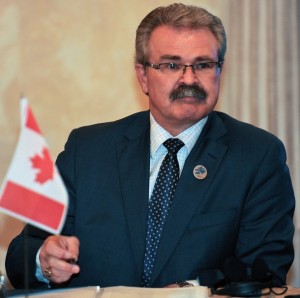André Picard, the long-time health reporter for Toronto’s Globe and Mail, writes this morning that XL Foods, whose unsanitary, licence-violating practices over five days resulted in at least 15 people being poisoned with E. coli and sparked the largest red-meat  recall in Canadian history, plans to be back in the slaughtering business by week’s end and shipping meat to stores again within 10 days.
recall in Canadian history, plans to be back in the slaughtering business by week’s end and shipping meat to stores again within 10 days.
By all appearances, there will be no fines, no sanctions, no extra scrutiny, no public inquiry.
Don’t we teach our children that, when you screw up, there are consequences?
Apparently that is not the case in Canadian agribusiness.
Instead, we are supposed to feel sorry for XL Foods because its infamous Establishment 58 was shut down for three weeks while it cleaned out the crap – literally, not just figuratively – and mopping-up operations were carried out across the country.
More than 2,000 food products were recalled in every province and territory. It is dumb luck, more than anything else, that so few people became seriously ill.
Gerry Ritz, the federal Minister of Agriculture and Agri-Food, whose job – presumably – is to ensure the safety of the Canadian food supply, seems to think that we should prostrate ourselves before the cattle and beef industry.
On the weekend, when XL Foods laid off 2,000 workers – a gesture that was arguably aimed at putting political pressure on the Canadian Food Inspection Agency to speed up its work so production could resume – Mr. Ritz took the bait whole hog.
“My thoughts are with the workers and the community affected,” he said.
The comments were eerily similar to those of the company’s co-CEO Brian Nilsson: “XL Foods is committed to the cattle industry, our employees, the city of Brooks and all affected by the idling of the Brooks facility.”
Clearly, the two protagonists in the sad affair can’t bring themselves to utter the c-word – consumer.
Shouldn’t consumer safety, not restarting the production line, be the paramount concern?
There have also been attempts to pass the buck to consumers. Repeatedly we have been told that E. coli is not a threat if you cook your meat properly.
That is not entirely true. In 1994, the U.S. Food Safety and Inspection Service reclassified E. coli as an “adulterant” that is not allowed in food. This change occurred after four children died and 600 other people were sickened by E. coli after eating Jack in the Box burgers. The beef was cooked but not enough to kill the pathogen.
“Just cook it doesn’t cut it,” says Doug Powell, a professor at Kansas State University who tracks food safety problems on his blog, barfblog.com.
Business as usual shouldn’t cut it either.
Or as Pat Atkinson of the Star Phoenix wrote this morning, Ministerial mediocrity seems to have risen to a new level in Canada.
 The beef breeding cow was discovered last month on a farm near Edmonton and was born on a nearby farm.
The beef breeding cow was discovered last month on a farm near Edmonton and was born on a nearby farm.


.jpg) with consumers, producers, industry and our provincial and territorial partners to ensure that our food safety system remains one of the best in the world."
with consumers, producers, industry and our provincial and territorial partners to ensure that our food safety system remains one of the best in the world.".jpg) of encouragement and enforcement to foster a food safety culture; and use technology to be transparent — whether it’s live webcams in the facility or real-time test results on the website — to help restore the shattered trust with the buying public.
of encouragement and enforcement to foster a food safety culture; and use technology to be transparent — whether it’s live webcams in the facility or real-time test results on the website — to help restore the shattered trust with the buying public. stating,
stating,.jpg) and I think in this case, certainly it could always be worse and we try to make a better system as we move forward."
and I think in this case, certainly it could always be worse and we try to make a better system as we move forward."